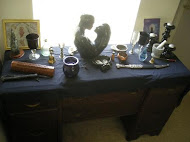Fairy Flora
by Eileen Holland, © Eileen Holland, Open Sesame
Alder - Alder is a charm against malevolent fairies. Water sprites are said to protect alder trees, so be cautious of cutting one down. Clethrad is an alder fairy known to us from mythology.
Apple - Fragrant apple bark can be added to incense that is burned as an offering to the fae on Midsummer Eve. The fruit or bark of apple trees can be used in fairy magic, especially for love spells. Apples are suitable offerings to the fae.
Ash - Ash trees are believed to provide protection from fairies, who are said to be unable to harm anyone standing in the shadow of an ash tree. Placing ash berries in a cradle is said prevent fairies from taking the baby and trading a changeling for it. (Also see Hawthorn)
Birch - Ghillie Dhu, a Scottish fairy who wears moss and leaves, is said to live in birch thickets. According to the Hanes Taliesin, from the 13th century Red Book of Hergest: "On a switch of birch was written the first Ogham inscription in Ireland, namely seven B's, as a warning to Lug son of Ethliu, to wit, 'Thy wife will be seven times carried away from you into fairyland or elsewhere, unless birch be her overseer."
Blackberry - It was taboo to eat blackberries in Celtic countries - a cause des feés - because of the fairies.
Blackthorn - Blackthorn trees and shrubs are said to be held sacred by fairies. The Luantishees are blackthorn fairies, who guard the trees. November 11 is their festival.
Bluebell - Some consider bluebells the most potent plant for fairy magic. Fields of bluebells are said to be so dangerously enchanted by fairies that a child who wanders into one may be held captive there by the fae. Adults who enter bluebell patches may become so enchanted that they are unable to leave until other humans come to lead them out. Plant bluebells to attract fairies to your garden. They are said to be called to their midnight revels by the sound of bluebells chiming. If you hear a bluebell ringing, this indicates the presence of a malicious fairy.
Clover - Fields of clover are believed to attract fairies. A four-leaf clover is said to provide protection against the fae, and to be able to break fairy spells and glamours. Wearing a four-leaf clover in your hat supposedly grants you the power to see invisible fairies, as does anointing yourself with an ointment made from four-leaf clover, or carrying a charm made of seven grains of wheat and a four-leaf clover.
Cowslip - Cowslip blossoms are said to be loved by fairies, who use them for umbrellas, and protect the plants. Shakespeare had a fairy say of cowslips:
"And I serve the Fairy Queen,
To draw her orbs upon the green.
The cowslips tall her pensioners be,
In their gold coats spots you see:
Those be rubies, fairy favors:
In those freckles live their savors.
I must go to seek some dewdrops here,
And hang a pearl in every cowslips' ear."
"That they do dwell within the cowslips hollow is truth for I have seen them fly out in intoxicated abandon."
Edmund Canterbell
Cowslips are used in fairy magic. They are considered helpful in finding fairy treasures, and keys to unlocking the secret location of hidden fairy gold.
Daffodil - Daffodils are useful for evoking fairies and elves.
Dogwood - Pixy Pears is one name for the tree's fruit.
Daisy - Daisies are used in fairy magic, for working with elves or fairies. Putting a daisy chain on a child is said to prevent fairies from beguiling the child and carrying her or him away.
Elecampane - Elfwort and Elf Dock are folk names for elecampane, an herb whose roots are used in fairy magic. Scattering the root about is said to attract fairies to your home, and growing elecampane is said to attract them to your garden.
Elder - Elder trees and bushes are said to protect fairies, especially at night, from negative energy and from people and entities who would do them harm. It was a British belief that placing a child in an elder wood cradle could cause it to be pinched black and blue by fairies. Elderberry wine is considered fairy wine. Drinking it is said to enable you to see fairies. Add dried elderberries to an incense mixture that you burn to attract fairies to a gathering.
Fairy Wand - Fairy Wands (Dierama pulcherrima) are associated with Titania, Shakespeare's fairy queen. They are used magically to call upon the fae for help.
Fern - Ferns are favored by pixies, who are said to sometimes be found near them.
Fig Tree - The Apsaras, also called Sky Dancers, are fig tree fairies (devas) ho are known to us from Hindu mythology. They bless humans at important stages of our lives. They also sometimes seduce scholars and scientists, and sexually exhaust them so that they will not discover things which are better left alone. Evoke the Apsaras for blessings, sex magic, and for good luck and protection for gamblers.
Flax - Purging Flax (Linum catharticum) is also called Fairy Flax.
Forget-Me-Not - Forget-Me-Not flowers provide protection from fairies. They are said to help to unlock the secrets of the fae, and pave the way to fairy treasures.
Foxglove (*Poison) - Folk names for foxglove include Fairy Thimbles, Fairy Glove, Little Folks' Glove, Fairy Fingers, Fairy Petticoats, Fairy's Cap, and Fairy Weed.. Foxglove is strongly associated with fairies, who are said to wear the tiny flowers as hats and gloves, and to leave their fingerprints upon the flowers. Foxglove is used in fairy magic, and for the evocation of elves or earth elementals. The leaves are said to grant release from fairy enchantment. Planting foxglove is an invitation to fairies to enter your garden. Wearing foxglove is a charm to attract fairy energy. The juice of the plant is said to be effective in breaking fairy enchantments.
Grass - Small fairies are said to ride bundles of grass as horses.
Hawthorn- Hawthorn, also called Whitethorn and Fairy Thorn, is the thorn in Oak, Ash, and Thorn. A grove comprised of those three trees was believed to be the perfect habitat for fairies, and an excellent place to catch sight of them. Pixie Pears is another name for hawthorn berries.
Heather- Heather stalks are said to provide food for fairies. A field of heather may contain a portal to the Fairy Kingdom.
Holly - Holly berries are said to be a fairy favorite.
Hollyhock - Fairies are said to love hollyhocks, especially pink ones.
Lavender - Elf Leaf is another name for lavender, which is used in elfin magic.
Lilac - The scent of lilacs is said to attract fairies to a garden.
Mistletoe - Adding mistletoe to a fairy spell on Midsummer Night's Eve makes the spell more powerful.
Morning Glory - Plant morning glories in your garden to keep away hostile fairies, especially nocturnal ones.
Mushrooms & Toadstools - Mushrooms and toadstools with knobbed caps are said to be used as stools and umbrellas by small fairies. Some of the folk names for various types of fungi reflect this belief: Fairy Club, Elf Cap, Pixie Hood, Dryad's Saddle, Elf's Stool, etc. A circle of mushrooms on a lawn is called a Fairy Ring, Fairy Circle, Fairy Dance, or Fairy Court. Fairy rings were believed to be places of dangerous enchantment that formed where fairies danced.
Nut Trees - Nut trees provide homes for the Caryatids, who are nut tree nymphs or fairies.
Oak - In British folklore ancient, hollow oak trees that stood in old sacred groves were often believed to be the homes of elves or fairies. Such trees were called bull oaks in England, and bell oaks in Scotland and Ireland. You were supposed to turn your coat or cloak inside out to neutralize their magic:
"Turn your clokes
For fairy folks
Are in old oaks."
Any oak tree may provide a home to fairies, elves, or other such beings. Dryads are oak tree nymphs. (Also see Hawthorn)
Orchid - Hammarbya paludosa is called Green Fairy Orchid.
Pansy - Plant pansies to attract fairies to your garden. Oberon, the fairy king, used pansies in his love potion
"Yet marked I where the bolt of Cupid fell.
It fell upon a little western flower;
Before, milk-white; now purple with love's wound-
And maidens call it Love-in-idleness.
Fetch me that flower, the herb I showed thee once.
The juice of it, on sleeping eyelids laid,
Will make a man or woman madly dote
Upon the next live creature that it sees."
"A Midsummer Night's Dream"
Peach - Some consider peaches to be fairy fruit.
Pear - Japanese pears were called Fairies' Fire in the old Language of Flowers.
Pearlwort - Placing a spring of pearlwort above the front door is said to prevent fairies from stealing any member of the household away.
Peony - Peonies are a charm to bring dreams of fairies.
Primrose - Primroses were considered fairy flowers in Ireland and Wales, where they were believed to grant fairies the power of invisibility. Eating primroses is supposed to enable you to see fairies. Hanging a spray of primroses on your door is said to be an invitation to the fae to enter your home, and to draw fairy blessings; but scattering primroses outside your door is said to keep fairies away by making a barrier that they cannot cross. Touching a fairy rock with a primrose posy that contains the right number of blossoms (try five) is said to open the way to Fairyland and fairy gifts. Be cautious though, for using a bouquet with the wrong number of flowers is said to bring certain doom. Use primroses for fairy magic. Plant primroses in your garden to attract fairies to it. Be sure to take good care of them though, for allowing primroses to languish or die is said to earn you the enmity of fairies.
Ragwort - Ragwort stems are said to be used as horses by tiny fairies.
Rose - Cultivate roses to attract fairies to your garden. Rose petals can be used in fairy magic, especially for love spells.
Rosemary - Grow rosemary, or place fresh sprigs of it about, to keep malicious fairies away. Burn dried rosemary as incense to attract the fae.
Rowan - The presence of a rowan tree in the yard or garden is said to provide the home and family with fairy blessings, and the protection of the fae. Rowan is also believed to provide protection from fairy spells. Rowan was once used as a charm to prevent fairies from spoiling butter as it was churned. In Scotland, the smoke from fires kindled of rowan wood was used to protect cattle from malicious fairies.
St. John's Wort - St. John's Wort is said to offer protection from the fae, and from fairy spells.
Thistles - Thistles are also called Pixies' Gloves, because the fae are said to use the tiny flowers as gloves.
Thorn Trees - All thorny trees, such as blackthorn and hawthorn, are said to serve as meeting places for fairies. Kindling a fire of thornwood atop a fairy mound is said to force the fae to return a stolen child.
Thyme - Thyme is associated with fairies. Wearing a sprig of wild thyme, or essential oil of thyme, is said to help one to see fairies. If you place springs of thyme on your closed eyes and sleep upon a fairy mound, this will supposedly guarantee your seeing fairies. Dried, powdered thyme, sprinkled on doorsteps and windowsills, is an invitation to the fae into your home. Wild thyme, gathered from the side of a fairy mound, is especially potent for use in fairy magic.
Violet - Violets are sacred to the Fairy Queen, and may be used in fairy spells.
Willow - The wind in the willows is said to be the whisperings of a fairy in the ear of a poet. Heliconian is a willow fairy who is known to us from mythology.
Wood Sorrel - Wood sorrel is used in fairy magic, and for the evocation of elves.
Fair Use Notice: This page may contain copyrighted material the use of which has not been specifically authorized by the copyright owner. This website distributes this material without profit to those who have expressed a prior interest in receiving the included information for research and educational purposes. We believe this constitutes a fair use of any such copyrighted material as provided for in 17 U.S.C § 107.
Disclaimer: No one involved in this blog or its contents may be held responsible for any adverse reactions arising from following any of the instructions/recipes on this list. It is the reader’s personal responsibility to exercise all precautions and use his or her own discretion if following any instructions or advice from this blog.















No comments:
Post a Comment